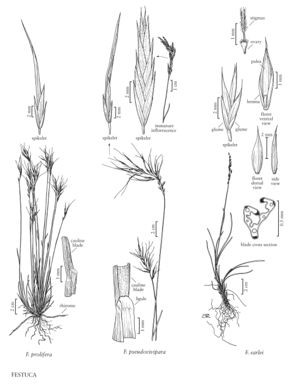Difference between revisions of "Festuca earlei"
FNA>Volume Importer |
FNA>Volume Importer |
(No difference)
| |
Revision as of 19:16, 24 September 2019
Plants loosely cespitose, often with short rhizomes. Culms (15)20-40(45) cm, glabrous, smooth. Sheaths closed for about 1/2 their length, glabrous, shredding into fibers, sometimes slowly; collars glabrous; ligules 0.1-0.5(1) mm; blades to 3 mm wide when flat, 0.5-1 (1.5) mm in diameter when conduplicate, veins (3)5, ribs (1)3(5), abaxial surfaces smooth or slightly scabrous, adaxial surfaces sparsely scabrous; abaxial sclerenchyma in 3-5 narrow strands less than twice as wide as high; adaxial sclerenchyma absent. Inflor¬escences 3-5(8) cm, contracted, with 1-3 branches per node; branches stiff, erect, scabrous, lower branches with 2+ spikelets. Spikelets (4.5)5-6.5(7) mm, with 2-5 florets. Glumes exceeded by the upper florets, lanceolate to ovate-lanceolate, mostly smooth, sometimes scabrous distally; lower glumes 1.5-3 mm; upper glumes 2.5-3.8 mm; lemmas 3-4.5 mm, glabrous or puberulent near the apices, awns (0.3)1-1.5 mm, terminal; paleas as long as or slightly shorter than the lemmas, intercostal region puberulent distally; anthers 0.6-0.9(1.4) mm; ovary apices densely and conspicuously pubescent. 2n = unknown.
Distribution
Colo., Ariz., N.Mex., Utah
Discussion
Festuca earlei grows in rich subalpine and alpine meadows, at 2800-3800 m, in Utah, Colorado, Arizona, and New Mexico. It often grows with the non-rhizomatous species F. brachyphylla subsp. coloradensis (p. 428) and F. minutiflora (p. 434). It can be distinguished from the former by its pubescent ovary apices, and from the latter by its larger spikelets and lemmas. Because of its short rhizomes (which are often missing from herbarium specimens), F. earlei is sometimes confused with members of the F. rubra (p. 412) complex. It differs from them in having pubescent ovary apices and shorter anthers.
Selected References
None.
